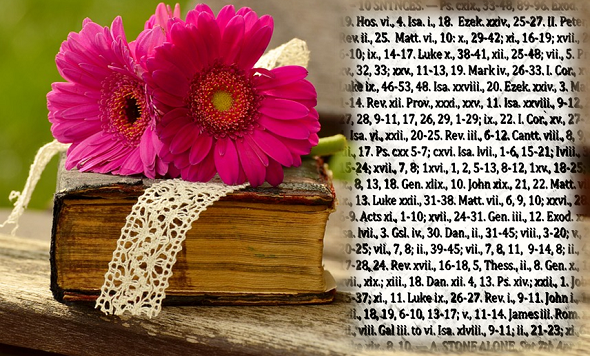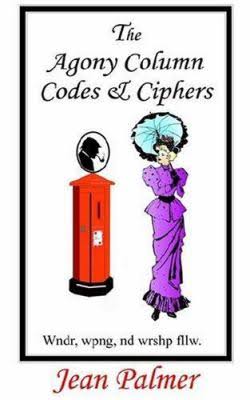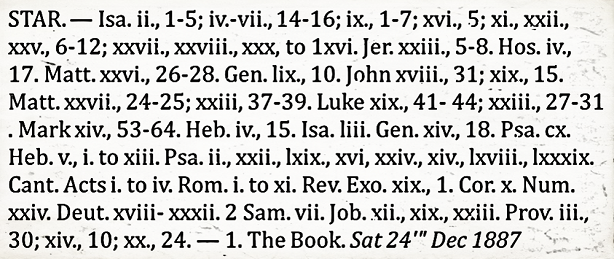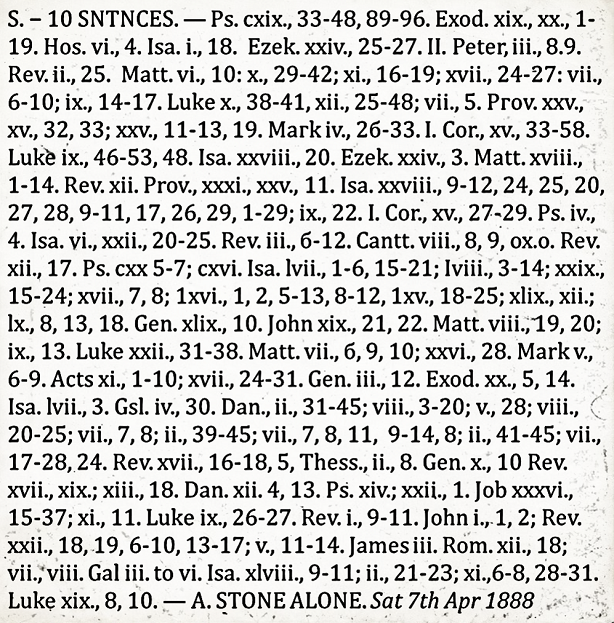Two years ago, I blogged about five encrypted 19th century newspaper ads that contain Bible references. Blog reader Thomas Ernst found an interesting solution approach, but so far nobody has deciphered these cryptograms.
The book The Agony Column Codes & Ciphers by Jean Palmer (i.e., Tony Gaffney) is a treasure trove for everybody interested in old cryptograms. To my regret, this work is not available any more in bookshops. I still hope that Tony, who is a reader of this blog, will publish a new edition one day.
The Agony Column Codes & Ciphers presents over a thousand encrypted newspaper advertisements, mainly from 19th century England. Many of these encrypted ads contain love messages. Others were placed by business people in order to send news to partners and customers. Ignatius Pollaky, a private investigator of the Victorian era, communicated via newspaper ads, too.
Tony, who is an excellent codebreaker, has solved most of the cryptograms described in his book. Nevertheless, some still wait to be deciphered. On Klausis Krypto Kolumne I have published many an article about these crypto mysteries. More articles of this kind will certainly follow, as there are still a few nice unsolved ads left.
Five ads in the Morning Post
In 2016, I introduced five encrypted advertisements, which were published in The Morning Post in 1887 and 1888. Here’s the first one (published on an Easter Sunday):
As can be seen, this ad contains a number of Bible references. For instance, the Psalms (Psal), the Epistle to the Romans (Rom), and the Book of Ezekiel (Ezek) are mentioned.
It is completely unclear to me what the plaintext parts mean. Did the author see a play named “The Aze full”? A Google search for this title didn’t find anything. The words “Aze” and “Hitchor” do not exist in English.
Here’s the second ad:
The first biblical passage referenced (Psalm 32,7-8) reads as follows:
You are my hiding place; you will protect me from trouble and surround me with songs of deliverance. I will instruct you and teach you in the way you should go; I will counsel you with my loving eye on you.
The second reference (Mal 3,6) leads to the following passage:
For I the Lord do not change; therefore you, O children of Jacob, are not consumed.
Here’s the third ad:
This ad consists only of Bible references.
The fourth ad was published in April 1888:
I don’t know what SNTNCES and STONE ALONE mean. The rest of the ad mainly consists of Bible references.
Here’s the last advertisement:
The expressions “Cantt.” and “Oxo” don’t fit to books in the Bible.
What’s behind it?
Who might have placed these ads and for what purpose? My first hypothesis was that these Bible references represent a book code, which would mean that every reference stands for a letter or word in the Bible.
My next guess was that these Bible passages were selected from a theological point of view. Perhaps, they were created by a priest who wanted to provide his parishioners with Bible study instructions. This hypothesis is supported by the fact that one of the ads was published on an Easter Saturday and another one on Christmas Eve.
I also thought it possible that every Bible reference has a precisely defined meaning (e.g., “Matt. 20” means “buy 20 stocks of company XY”). An encryption method of this kind is referred to as Jargon code.
None of these guesses led to anything.
# 1: “2 12 7 8 9 1 12 3 1 17 28 69 19 20 71 5 9 13 31 10 11 29 2 19 12 13 14 42 16 2 9”.
# 2: 32 7 8 3 6.
# 3: 2 1 5 4 7 14 16 9 1 7 16 5 11 22 25 6 12 27 28 30 1 16 23 5 8 4 17 26 26 28 59 10 18 31 19 15 27 24 25 23 37 39 19 41 44 23 27 31 14 53 64 4 15 53 14 18 110 1 13 2 22 69 16 24 14 68 891 4 1 11 19 1 10 24 18 32 2 7 12 19 23 3 30 14 10 20 24 1.
# 4: 119 33 48 89 96 19 20 1 19 6 4 1 18 24 25 27 2 3 8 9 2 25 6 10 10 29 42 11 16 19 17 25 27 7 6 10 9 14 17 10 38 41 12 25 48 7 5 25 15 32 33 25 11 13 19 4 26 33 1 15 33 58 9 46 53 48 28 20 24 3 18 1 14 12 31 25 11 28 9 12 24 25 20 27 28 9 11 17 26 29 1 29 9 22 1 15 27 29 4 4 6 22 20 25 3 6 12 8 8 9 [0xo?] 12 17 120 5 7 116 57 1 6 15 21 58 3 14 29 15 24 17 7 8 1 16 1 2 5 13 8 12 1 15 18 25 49 12 60 8 13 18 49 10 19 21 22 8 19 20 9 13 22 31 38 7 6 9 10 26 28 5 6 9 11 1 10 17 24 31 3 12 20 5 14 57 3 4 30 2 31 45 3 20 5 28 8 20 25 7 7 8 2 39 45 7 7 8 11 9 14 8 2 41 45 7 17 28 24 17 16 18 5 2 8 10 10 17 18 19 6 10 13 17 11 14 3 12 18 7 8 3 6 48 9 10 2 21 23 11 6 8 28 31 19 8 10.
# 5: 1 27 29 8 8 9 [Oxo] 34 15 37 42
In my view, this interpretation makes sense. Nevertheless, the five cryptograms are still unsolved. Can a reader find out more about this mystery?
Follow @KlausSchmeh
Further reading: Please help to decrypt these 25 newspaper advertisements
Linkedin: https://www.linkedin.com/groups/13501820
Facebook: https://www.facebook.com/groups/763282653806483/










Kommentare (3)